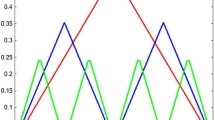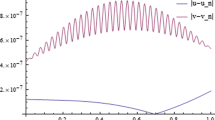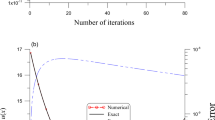Abstract
In this paper, we will first study the existence and uniqueness of the solution of an inverse initial-boundary-value problem, via an auxiliary problem. Furthermore, we propose a stable numerical approach based on the use of the solution to the auxiliary problem as a basis function for solving this problem in the presence of noisy data. Also note that the inverse problem has a unique solution, but this solution is unstable and hence the problem is ill-posed. This instability is overcome using the Tikhonov regularization method. The effectiveness of the algorithm is illustrated by numerical example.






Similar content being viewed by others
References
Abtahi M, Pourgholi R, Shidfar A (2011) Existence and uniqueness of solution for a two dimensional nonlinear inverse diffusion problem. Nonlinear Anal (TMA) 74:2462–2467
Alves CJS, Chen CS, Saler B (2002) The method of fundamental solutions for solving Poisson problems. International series on advances in boundary elements. Boundary Elements XXIV 13:67–76
Anger G (1990) Inverse problems in differential equations. Plenum Press, New York
Bard A, Faulkner LR (1980) Electrochemical methods. Wiley, New York
Bazant MZ, Chu KT, Bayly BJ (2005) Current voltage relations for electrochemical thin film. SIAM J Appl Maths 65:1463–1484
Beck JV, Blackwell B, St CR (1985) Clair, inverse heat conduction: ill-posed problems. Wiley-Interscience, New York
Beck JV, Blackwell B, Haji-sheikh A (1996) Comparison of some inverse heat conduction methods using experimental data. Int J Heat Mass Transf 3:3649–3657
Bhat YS, Moskow S (2007) Linearization of a nonlinear periodic boundary condition related to corrosion modeling. J Comput Math 25:645–660
Biegert M, Warma M (2009) The heat equation with nonlinear generalized Robin boundary conditions. J Differ Equ 247:1949–1979
Cabeza JMG, Garcia JAM, Rodriguez AC (2005) A sequential algorithm of inverse heat conduction problems using singular value decomposition. Int J Therm Sci 4:235–244
Cannon JR (1984) The one-dimensional heat equation. Addison Wesley, Reading
Hansen PC (1992) Analysis of discrete Ill-posed problems by means of the L-curve. SIAM Rev 34:561–580
Hansen PC (1998) Rank-deficient and discrete ill-posed problems. SIAM, Philadelphia
Hömberg D, Krumbiegel K, Rehberg J (2013) Boundary coefficient control—a maximal parabolic regularity approach (Preprint)
Hon YC, Wei T (2004) A fundamental solution method for inverse heat conduction problem. Eng Anal Boundary Elem 28:489–495
Lawson CL, Hanson RJ (1974) Solving least squares problems, Philadelphia, PA: SIAM, 1995. First published by Prentice-Hall (1974).
Murio DA (1993) The mollification method and the numerical solution of ill-posed problems. Wiley-Interscience, NewYork
Murio DC, Paloschi JR (1988) Combined mollification-future temperature procedure for solution of inverse heat conduction problem. J comput Appl Math 23:235–244
Molhem H, Pourgholi R (2008) A numerical algorithm for solving a one-dimensional inverse heat conduction problem. J Math Stat 4:60–63
Newman J (1968) Engineering design of electrochemical systems. Ind Eng Chem Fundam 60:12–27
Newman J (1973) Electroanalytical chemistry, vol 6. Marcel Dekker, New York
Pazy A (1983) Semigroups of linear operators and applications to partial differential equations, Applied Mathematical Sciences, 44. Springer, New York
Pourgholi R, Azizi N, Gasimov YS, Aliev F, Khalafi HK (2009) Removal of numerical instability in the solution of an inverse heat conduction problem. Commun Nonlinear Sci Numer Simul 14:2664–2669
Pourgholi R, Rostamian M (2010) A numerical technique for solving IHCPs using Tikhonov regularization method. Appl Math Model 34:2102–2110
Pourgholi R, Rostamian M, Emamjome M (2010) A numerical method for solving a nonlinear inverse parabolic problem. Inverse Probl Sci Eng 18:1151–1164
Rousar I, Micka K, Kimla A (1986) Electrochemical engineering. 1. Elsevier, Amsterdam
Shidfar A, Azary H (1997) Nonlinear parabolic problems. Nonlinear Anal Theory Methods Appl 30:4823–4832
Shidfar A, Pourgholi R (2006a) Numerical approximation of solution of an inverse heat conduction problem based on Legendre polynomials. Appl. Math. Comput 175:1366–1374
Shidfar A, Pourgholi R, Ebrahimi M (2006b) A Numerical Method for Solving of a Nonlinear Inverse Diffusion Problem. Comput Math Appl 52:1021–1030
Tikhonov AN, Arsenin VY (1977) On the solution of ill-posed problems. Wiley, New York
Yan L, Yang FL, Fu CL (2009) A meshless method for solving an inverse spacewise-dependent heat source problem. J Comput Phys 228:123–136
Author information
Authors and Affiliations
Corresponding author
Additional information
Communicated by Ruben Spies.
Rights and permissions
About this article
Cite this article
Pourgholi, R., Esfahani, A., Rahimi, H. et al. Solving an inverse initial-boundary-value problem using basis function method. Comp. Appl. Math. 32, 27–40 (2013). https://doi.org/10.1007/s40314-013-0005-y
Received:
Revised:
Accepted:
Published:
Issue Date:
DOI: https://doi.org/10.1007/s40314-013-0005-y
Keywords
- Inverse initial-boundary-value problem
- Existence
- Uniqueness
- Tikhonov regularization method
- The L-curve method




